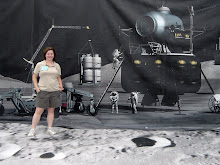That was my campaign promise when I took on the role of Keeper of the Plan. This is a science team job in the daily planning process that puts together the plan of activities that science wants that day and hands it off to the engineering team. I love it because it's detail-oriented, like me, and because it's another one of those jobs that gets me working with the engineers, which I love. Anyway, I had facetiously said that because I was the one putting activities into the plan, I could slip in my favorite ones - which of course, I can't do - both because obviously we do what the team wants every day but also because of the huge issue that my favorite instruments, APXS and MB, are on the end of the long rover arm and I can't personally command that to move too.
But this week, I had the distinct pleasure of *almost* making my campaign promise come true. This week, both rovers got down and dirty, putting their instruments on the ground. Opportunity is working on a week-long campaign to characterize the "dark streaks" emanating from Victoria Crater. The way we decided to do this was to first go to a spot between two streaks that looked "normal" and then go to the place with the darkest soil. On both spots, we did a whole series of observations, including photometry (photographs at different times of day on the same sopt to see how the soils' spectral characteristics change with sun angle), Microscopic Imager photos (to see what the soils look like on a fine scale, are there blueberries, is the sand different sizes, etc.), and APXS (to get the composition of the soil).
Spirit worked all week on characterizing Elizabeth Mahon, an outcrop of light-toned rock near Home Plate that may be in-place exposures of the lowest stratigraphic unit - exciting for geologists, really! Spirit spent a week on this one outcrop, largely because of the time it takes to conduct Mossbauer observations. We did four days (96 hours!) of Mossbauer on this rock. Mossbauer works by inducing a response from iron in the rock and then detecting its spectrum. To induce the transition in the iron, the Mossbauer carries a little source, and that source is getting old and weak. In the beginning of the mission, we only needed half a day or a day of Mossbauer integration to understand the iron mineralogy of the target. With each new day of the mission, we need to spend longer and longer to get a good spectrum. Because this rock is an important one for understanding the geology of Home Plate, we made the commitment to get a really good Mossbauer analysis here, plus APXS data for elemental composition and Microscopic Imager photos of the rock itself - which show it's an interesting, irregular, windscuplted rock. MI images are pretty cool - here are some of the Elizabeth Mahon shots this one and another one, or go check them all out!
Subscribe to:
Post Comments (Atom)

No comments:
Post a Comment